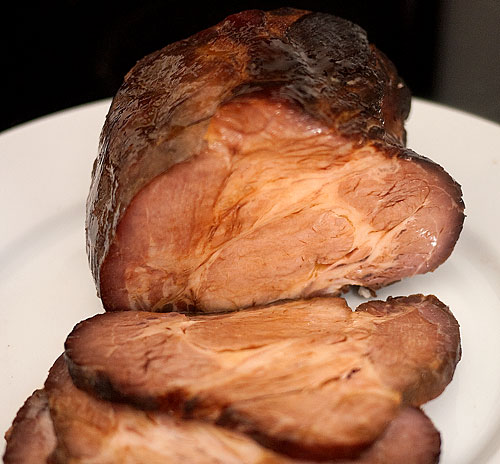Char siu or yakibuta - Chinese style roast pork

I have posted a recipe for char siu, or Chinese style roast pork, previously. But that was way back in 2004, and my standard go-to recipe has changed a bit since then. Plus, it makes a great staple for bentos, so here it is.
Char siu, called yakibuta in Japanese (in Japan it's called by both names チャーシュー or 焼豚)is used in many everyday dishes. It is very rich, so it's usually used in small quantities, not eaten as a hunk o' meat. Here are just a few ways you can use it:
- top off a bowl of ramen with one or two thin slices
- cut into cubes and add to fried rice
- roughly chopped and use as a filling for steamed buns (where my original char siu recipe appeared)
- minced and use as a shumai filling
- as a sandwich meat
- cut into strips for salads or stir fries
Or, you can just cut a few slices or strips to tuck into the corner of your bento as-is.
It does take some time to prepare and cook, but your actual kitchen time is minimal. You can store it in the refrigerator for a few days, or cut it up and freeze it. The marinade can be used as a sauce too. It's a very frugal dish, and one of my favorite ways to cook pork.
Note that this recipe has just a few more ingredients than my original recipe, and a more complex flavor. If you cannot find sake or shaoxing wine, or can't use alcohol for some reason, please try the alcohol-free recipe that I posted previously (scroll down for the roast pork recipe). If you don't have an oven, try my nibuta (stewed pork) recipe.
The cut of pork you use is very important. I usually use either the shoulder or the neck, both of which have some marbling but not too much. They're also usually fairly reasonably priced. The butt is fine to use too. Loin is lower in fat and not that suitable for this. Filet is very low in fat, not to mention expensive, so the char siu will be rather dry. Belly or ribs are too fatty.
Commercial char siu is sometimes dyed a bright red color, which I have omitted here.
Recipe: Char siu or yakibuta - Chinese style roast pork
- A bit more than 2 lbs (1kg) pork shoulder or neck
For the marinade:
- 1 cup (360ml) soy sauce
- 3 Tbs. oyster sauce
- 5 Tbs. sugar
- 1/2 cup shaoxing wine (紹興酒)or sake or dry sherry
- an inch-long (2cm) piece of fresh ginger, peeled and sliced
- 1 small onion, peeled and cut into quarters
- 2 garlic cloves, peeled and crushed with a knife
- 1 cinnamon stick
- 1 small piece of star anise
- 1 clove
Poke the lump of pork all over with the point of your knife. This allows the marinade to penetrate the meat better.
If you want your pork to be a neat, even bundle, wind some kitchen string around it tightly. I usually skip this step.
Combine all of the marinade ingredients in a bowl.
Put the pork in a sturdy plastic zip bag, then put another bag over it (the second bag catches any leaks - and believe me, that first bag always leaks.) Pour the marinade into the inner bag. Express as much air as you can out of the bag, and close it. Close the outer bag also.
Place the bagged pork on a plate, and put it in the refrigerator. Marinate it for at east 3 hours or overnight. Turn it around occasionally to distribute the marinade evenly.
When you are ready to cook it, preheat the oven to 450°F (220°C). Take the pork out of the bag and put it in an oven baking dish. Add the marinade. Roast the pork at the high temperature for 15 minutes, then lower the temperature to 250°F (120°C). Turn the pork over.
Roast the pork for 1 1/2 to 2 additional hours, turning it every 30 minutes, or until an oven thermometer registers an internal temperature of 160°F (70°C). Take the baking dish out of the oven and let the meat cool in the marinade, turning occasionally to moisten the meat surface. Cool down before slicing.
Char siu will keep in the refrigerator for 4-5 days, and in the freezer for up to 3 months.
To store in the freezer: I find it's easiest to use if I cut it up before freezing. I cut some of it into slices, some into cubes, and some into strips, divide it all up into single-use portions, and freeze. Sometimes I add a drizzle of the marinade to the meat before packing it up. This amount of char siu lasts me for a good month, used in various dishes.
The marinade itself can be frozen too. Skim off the solidified fat from the surface of the cooled marinade, and strain it through a sieve. Put it in a plastic zip bag and lay flat in the freezer. Once frozen, you can just scoop out a little bit at a time with a spoon. Use a little bit in a stir-fry, fried rice, and so on.
Variations
You can make it sweeter by sprinkling the surface with sugar every time you turn the meat.
As an alternative to using the cinnamon stick, star anise and clove, use 2 tablespoons of Chinese five spice powder. You can also omit the spices entirely, for a simpler flavor.
Equipment note: Instant-read meat thermometers
If you are a meat-roasting newbie, I really recommend getting an oven thermometer - they really aren't expensive, and will take away any anxieties you may have over overcooking an expensive piece of meat.
If you enjoyed this article, please consider supporting this site by becoming my patron via Patreon.
